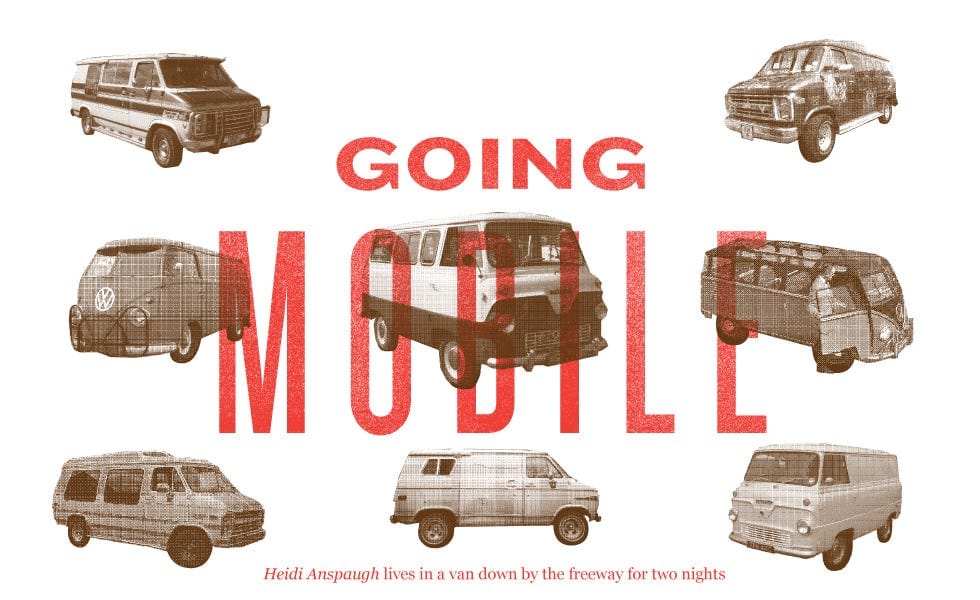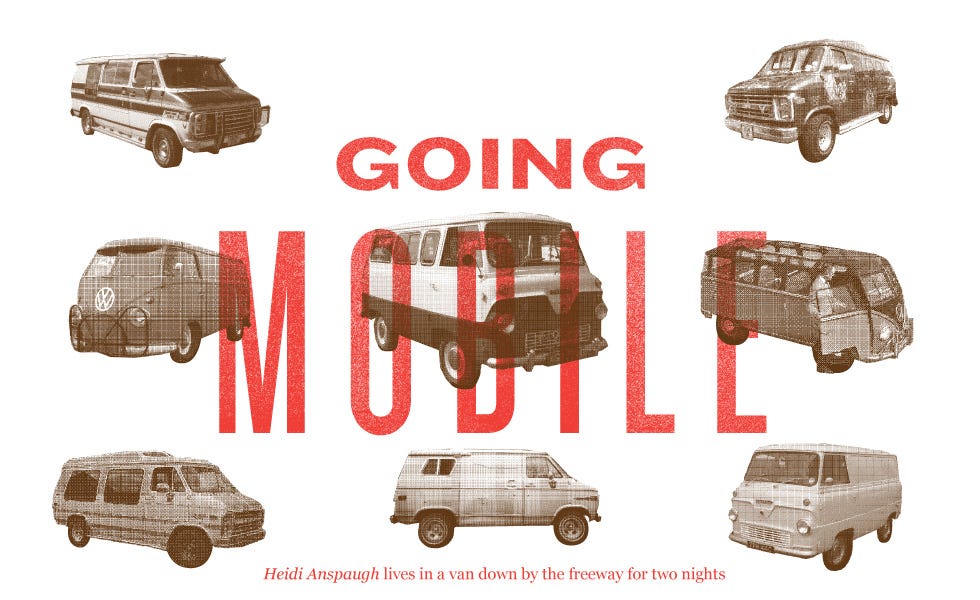
Living in this beautiful and expensive city during a recession can be challenging. Many of us in the past couple years have either gotten laid off, been on unemployment and are living on a prayer for an extension, or desperately wanted to quit a hated job but didn’t think it’d be a wise move. Some of us choose to grin and bear it. Others, like Glenn Calub (aka Glenny Kravitz), a local karaoke host, opt to live in their cars rather than be a slave to the San Francisco rental market.
Glenny is my ex-boyfriend and after I sent him posts about living in an RV by the Life Nomadic blogger Tynan Smith, he decided to give up regular creature comforts to live in a van while transitioning out of living with me in my cozy Glen Park house. He sold his economical Toyota Yaris, bought a used Chevy van, and started living in it part time. This was a difficult adjustment at first, since at best it was a good camping van and at worst held the barest of amenities with no kitchen, bathroom, or standing space. He got by mostly by parking on quiet streets in the Sunset, showering at 24 Hour Fitness, getting free Wi-Fi at cafés. He even ran karaoke parties out of his van — VANAOKE! Today, Glenn is almost 100% debt-free and can boast that he beat the recession by living his own version of the life nomadic.

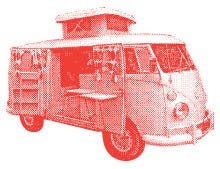
I find myself becoming more and more intrigued. Is living in your car really a sustainable way to live in San Francisco? When I regale coworkers over lunch with Glenn’s van tales, I hear: “Wow, that’s like my dream. If I lived in a van, I’d call myself Jean Claude Van Man.” I wonder if this lifestyle is really practical for someone with a 9 to 5 job. Where, for example, would I put all my shoes? I decide I have to road test this for myself, so I decide to borrow Glenn’s van for a couple nights of urban camping.
But before I commit myself to this experiment, I contact Glenn’s inspiration, Tynan Smith, who’s lived in an RV since 2007. Tynan’s been living “life outside the box”
ever since leaving home in his early 20s to live with a group of notorious pickup artists in a mansion in Hollywood (yes, the same crew written about by Neil Strauss in The Game). He works for himself, currently developing a start-up “because that’s what you do when you live in San Francisco.”
His choice to live in an RV was sparked by a wacky college scheme to buy a 40-foot school bus and live in it while traveling cross-country one summer. Inspired by the movie Road Trip, he and his friends planned to drive coast to coast before the bus died somewhere outside of Vegas. “I guess that’s where I got started on this whole living in a vehicle thing,” he explains.
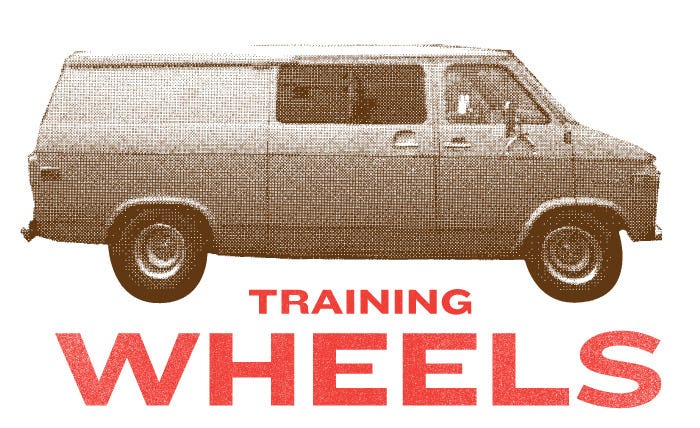
According to Tynan, there are practical matters to address before making the transition. You’ll have to either sell the majority of your belongings or put them in storage. To go the much more desirable RV route, there is an initial cost investment of not only buying the motor home (which will run you a few grand used), but of converting it. Tynan runs down the steps of pimping out your Winnebago: “Number one, you have to have solar power for electricity; running a generator is a jerk thing to do because it’s loud, there’s exhaust, and you annoy people nearby. That will cost you at least $1,000. You need to get a new fridge because all RVs are built for vacationing, not for living, so they have fridges that either use way too much battery or run on propane.
If they’re too off-level, they’ll actually explode. So you have to get a fridge that’s meant to specifically run on batteries. You basically have to redo everything.”
But after up-front costs, the cost of living is pretty minimal. Instead of paying hundreds or more in rent every month, you’ll pay $10 every 10 to 14 days to dump your tanks and fill up on water. Propane to fill up your tanks is $20, which you’ll spend about every two weeks in winter, and every one to two months in summer. Even better, travel is not only more feasible, but practical! If you road trip in your car/house, you’re not paying for hotels.
Aside from costs, there’s the issue of parking, which in SF isn’t easy. You don’t want to move your vehicle more often than necessary, but you do need to move your car weekly to avoid street cleaning tickets. When your car’s parked for the week, Tynan says you’ll need other forms of transportation (which also helps to keep gas costs down). He alternates between an electric skateboard, a motorcycle, and “a hilarious folding scooter.” If your house is also your only vehicle, like Glen’s van, you have the benefit of just parking right outside a gig or a party — you can avoid driving drunk by passing out in the van at the end of the night.

With Tynan’s advice in mind, I decide I’m ready to start my two-night adventure in Glen’s van. Lucky for me, it’s already equipped with a comfortable leather bench in the back that folds down to a full-size bed, and it has curtains and blinds for privacy. Now, I need to find a spot to park. I’d noticed a lot of vans parked down by the 3rd and 16th Street intersection under the freeway overpass. I decide to join the mobile shantytown and park for the night, since my job is nearby in SOMA. I wonder if I’ll actually be able to sleep.
Safety is definitely at the forefront of my mind, since I’ve chosen a semi-sketchy spot. I take comfort in Tynan’s assurance that he’s never had any break-in attempts — unless you count the police. Technically, it’s illegal to be in your vehicle past 10 p.m., but the cops can’t actually bother you if they can’t prove you’re IN the vehicle. People who live in their vehicles know: When the police come a-knockin’, DON’T ANSWER! This has happened to Tynan a few times: “They were rattling the door handle at, like, 1 a.m. and they never identify themselves as police.” Freaky. Pro tip: Get blackout curtains.
I spend the evening out with friends for dinner and drinks, and when we part ways and it’s time for bed, I head to the van. I have problems falling asleep in the best of circumstances, so this proves challenging. I watch a couple of TV shows on my fully charged laptop, and then it’s lights out. Naturally, every noise is a potential burglar/predator trying to break in. I drift off, only to bolt awake so many times I lose count. How do people do this? If I sleep with earplugs, I won’t hear the baddies coming. It’s a catch-22.
Waking up early is not a problem due to continued paranoia and early light. I head to my gym, which is only a few blocks away, where I shower and get ready for work. When I finally make it to the office, I clutch my grande soy double-shot latte in a death grip. My coworkers steer a wide path around me as I give new meaning to “not a morning person.”

The next night of my van-living experiment, I decide to park in a residential neighborhood. I don’t think I’ll ever get used to sleeping in a van — down by the freeway overpass. I find a good spot near the Panhandle away from the highly trafficked Fell and Oak Streets.
Before I drift off to sleep, I imagine future nights parked out by the ocean, roasting wienies on the camping stove — and it actually seems bohemian and romantic. I’m so exhausted from my previous sleepless night that I’m out almost instantly.
I wake up at the crack of dawn, and it’s cool to hear the city waking up around me. Today I have the extra commute to contend with, so instead of going to the gym first off, I decide to just get dressed, do a passable attempt at grooming in the van, and shower at my gym on my lunchbreak. When I emerge from the van at 7:30 a.m. in my work clothes, I get some funny looks, but I just smile and head on my merry way. I have a secret –I’m Jeanne Claude Van Woman.
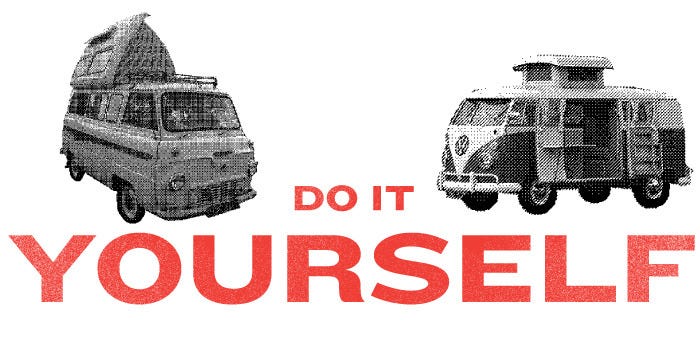
Parking : The Panhandle, Dolores Park, and the Sunset are all good spots. Safe neighborhoods, walking distance to food, and plenty of sun to charge up those solar panels. Show up an hour after street cleaning starts to secure a prime spot.
Practicalities: Join a gym or Kabuki Springs for showering. Go to cafés for free Wi-Fi. To get better gas mileage in RVs, remove things like A/C units. For those times when nature calls, you can get those portable kitty litter pans or pee in a bottle. Get a portable propane heater like a Coleman Sportcat to keep small spaces toasty, and use a camping stove for cooking.
Go Low-Pro : Don’t be cute and spray paint, tag, or mark up your vehicle with ironic bumper stickers or bon mots like, “Don’t laugh, your daughter’s in here.” This only calls more attention to you and makes you seem like a degenerate to both cops and residents. And to be a good citizen, pick up trash around the area.
Tips: Read Tynan’s blog posts to help get started:



